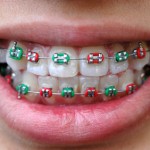
Pain and discomfort is often reported by patients undergoing orthodontic treatment and has been cited as a reason for failure to complete treatment. Removal of fixed appliances could be painful and it has been suggested that an intrusive bite force may stabilize teeth allowing greater resistance of torsional forces. The aim of this study was to determine; pain experience during orthodontic fixed appliance treatment; expectations of pain during the debonding of orthodontic fixed appliances; and whether biting on a soft acrylic wafer reduces pain experience during the debonding of orthodontic fixed appliances.
Patients aged 12-18 with full orthodontic fixed appliances in both arches with either Victory or SmartClip brackets (both 3M Unitek) precoated with APC adhesive were included. Patients were randomised to undergo a standardised debonding procedure with either a soft acrylic wafer in place to bite into (test group) or no wafer (control group). Prior to the debond anxiety levels and expectations of pain during the removal of their appliances were assessed using a visual analogue scale (VAS). Following the debond a second questionnaire to determine the actual amount of pain experienced. Overall pain and quadrant pain were assessed.
- 90 patients were randomised –45 in each group.
- Duration of fixed appliance treatment ranged from 12–48 months; mean 26.9 months
- Both groups had a similar level of anxiety about the debond and similar expectations of pain, with a full range of scores given (0–100).
- Debond of the lower anterior teeth was reported as the most painful by both groups
- The expected pain was significantly greater than that actually experienced (P ≤ 0.0001).
- The overall pain experienced and that experienced for all quadrants, except the lower anterior teeth, was lower in the wafer group than in the control group but this did not reach statistical significance.
- Multiple linear regression, adjusting for age, gender, type of molar attachment and the expected level of pain at debond found the wafer group had significantly less pain during debond of the upper posterior teeth (P=0.037) and the lower posterior teeth (P=0.031).
The authors concluded
Biting on a soft acrylic wafer during debond of the posterior teeth reduces the pain experienced. The lower anterior teeth are the most painful. The pain expected is significantly greater than actually experienced. Patients who had greater pain during treatment expected and experienced greater pain at debond.
Comment
As the authors note in the discussion while there has been some investigation of pain experienced during some orthodontic procedures; placement of separators, arch-wire placement and use of difference bracket systems little work has been published on debonding to date. While this study does show some benefit more pain was experienced by those with greater anxiety so work to reduce this may also be of benefit as suggested by the authors.
Links
Mangnall LA, Dietrich T, Scholey JM. A randomized controlled trial to assess the pain associated with the debond of orthodontic fixed appliances. J Orthod. 2013 Sep;40(3):188-96. doi: 10.1179/1465313313Y.0000000045. PubMed PMID: 24009318.

The patients in this study underwent a standardized debonding procedure with debonding pliers having right-angled beaks. Were the edges of the debonding pliers placed over the bracket base during debracketing? An answer concerning this point will be greatly appreciated. I am considering to plan a PhD thesis for my student in this area.
I sent an e-mail to Dr. Louise A.R. Mangnall asking the same question. Dr Mangnall is the first author of the paper entitled ‘A randomized controlled trial to assess the pain associated with debond of orthodontic fixed appliances’. I hope Dr Mangnall has received my e-mail. Dr Mangnall’s e-mail was given as follows: louise.mangnall@nhs.net